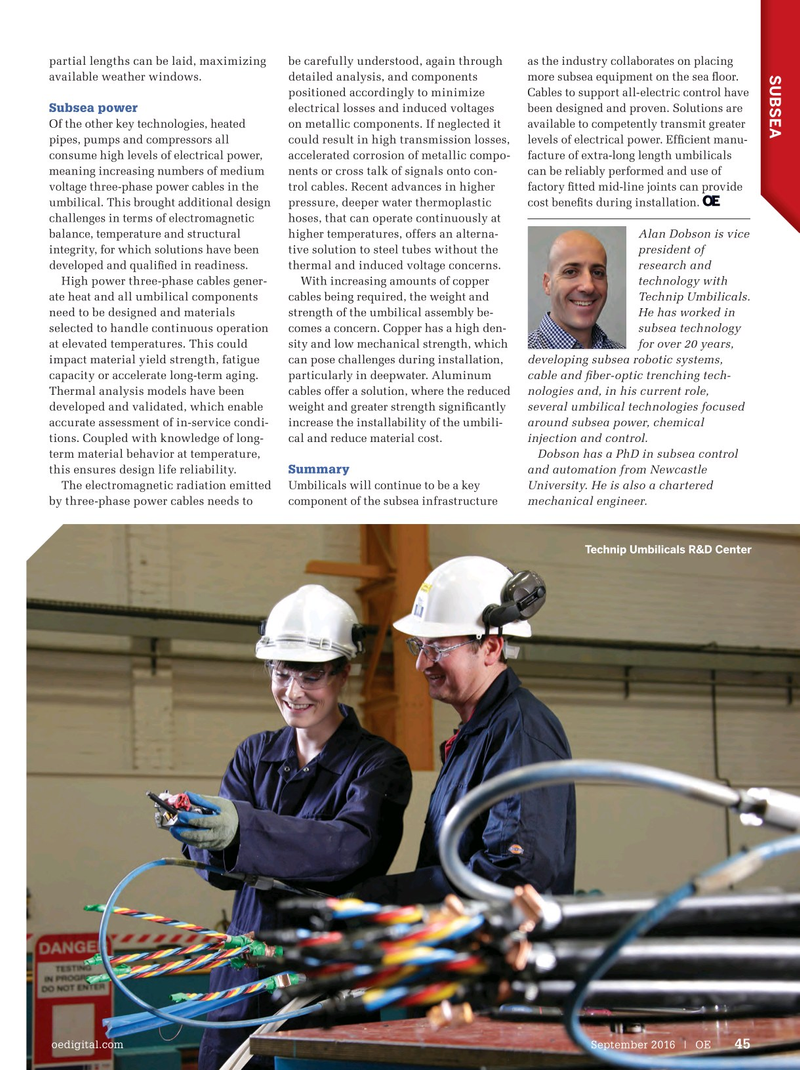
Page 43: of Offshore Engineer Magazine (Sep/Oct 2016)
Read this page in Pdf, Flash or Html5 edition of Sep/Oct 2016 Offshore Engineer Magazine
partial lengths can be laid, maximizing be carefully understood, again through as the industry collaborates on placing
SUBSEA more subsea equipment on the sea ? oor. available weather windows. detailed analysis, and components
Cables to support all-electric control have positioned accordingly to minimize
Subsea power been designed and proven. Solutions are electrical losses and induced voltages
Of the other key technologies, heated available to competently transmit greater on metallic components. If neglected it pipes, pumps and compressors all levels of electrical power. Ef? cient manu- could result in high transmission losses, consume high levels of electrical power, facture of extra-long length umbilicals accelerated corrosion of metallic compo- meaning increasing numbers of medium can be reliably performed and use of nents or cross talk of signals onto con- voltage three-phase power cables in the factory ? tted mid-line joints can provide trol cables. Recent advances in higher umbilical. This brought additional design cost bene? ts during installation. pressure, deeper water thermoplastic challenges in terms of electromagnetic hoses, that can operate continuously at
Alan Dobson is vice balance, temperature and structural higher temperatures, offers an alterna- president of integrity, for which solutions have been tive solution to steel tubes without the research and developed and quali? ed in readiness. thermal and induced voltage concerns.
High power three-phase cables gener- With increasing amounts of copper technology with ate heat and all umbilical components cables being required, the weight and
Technip Umbilicals. need to be designed and materials strength of the umbilical assembly be-
He has worked in selected to handle continuous operation comes a concern. Copper has a high den- subsea technology at elevated temperatures. This could sity and low mechanical strength, which for over 20 years, impact material yield strength, fatigue can pose challenges during installation, developing subsea robotic systems, capacity or accelerate long-term aging. particularly in deepwater. Aluminum cable and ? ber-optic trenching tech-
Thermal analysis models have been cables offer a solution, where the reduced nologies and, in his current role, developed and validated, which enable weight and greater strength signi? cantly several umbilical technologies focused accurate assessment of in-service condi- increase the installability of the umbili- around subsea power, chemical tions. Coupled with knowledge of long- cal and reduce material cost.
injection and control. term material behavior at temperature, Dobson has a PhD in subsea control
Summary this ensures design life reliability. and automation from Newcastle
Umbilicals will continue to be a key
The electromagnetic radiation emitted
University. He is also a chartered component of the subsea infrastructure by three-phase power cables needs to mechanical engineer.
Technip Umbilicals R&D Center oedigital.com September 2016 | OE 45 044_OE0916_Subsea2_Technip.indd 45 8/24/16 1:10 PM

 42
42

 44
44